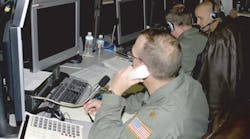By John Keller
Scientists at the U.S. Defense Threat Reduction Agency at Fort Belvoir, Va., are asking industry for ideas on how to blend electronic, optical, and mechanical technologies in a remote-control arm that can move like a snake.
This robotic snake-arm must, which would be at least three feet long, must be able to make several 90-degree bends on a 360-degree axis along its length, follow itself along a directed route, and carry an assortment of tools ranging from clamps to cutters.
Furthermore, this extendable and retractable snake-arm should have a free range of motion, have the ability to maneuver around a variety of obstacles in a variety of situations, and be self-supporting with exact position and motion-recall capability. No specific applications are named.
The Defense Threat Reduction Agency’s primary mission is to safeguard U.S. citizens from chemical, biological, radiological, nuclear, and high explosive weapons of mass destruction by reducing current threats and preparing for future threats.
Agency officials are asking for industry ideas for the snake-arm as part of a sources-sought market study that-at least for the time being-is asking only for five-page white papers rather than specific proposals. No solicitation for this project exists yet, agency officials caution. The sources-sought reference number is CSE059978339.
Agency officials are considering the technologies and applications related to the snake-arm market study for research and development efforts in federal fiscal 2006, starting in December 2005.
The arm must have a complementary-metal-oxide-semiconductor (CMOS) camera with infrared capability and a resolution of at least 3000 pixels for a live feed to the controller. The robotic snake arm must be battery-powered, man-portable, weigh less than 20 pounds, have a flat base for mounting to a variety of platforms, or be capable of stand-alone operations.
Agency officials want the snake-arm to be controllable from a laptop computer or personal digital assistant with a fiber-optic cable. The complete system, which should have a directional mobile-area network system, should be ruggedized and weather proof with the capability of working in a variety of circumstances and environments.
Agency officials asked for white papers that compare and contrast capabilities with current commercial-off-the-shelf technologies or known developmental efforts. They point out, however, that submitting a white paper is not a requirement to be considered for future related research programs.
Submit questions, comments, or more information contact contract specialist Wanda Maddox by e-mail to [email protected], by phone at 703-325-1306, by fax at 703-325-6226, or by post at Defense Threat Reduction Agency, DTRA Annex 8725 John J. Kingman Road, MSC 6201, Fort Belvoir, Va., 22060-6201.


